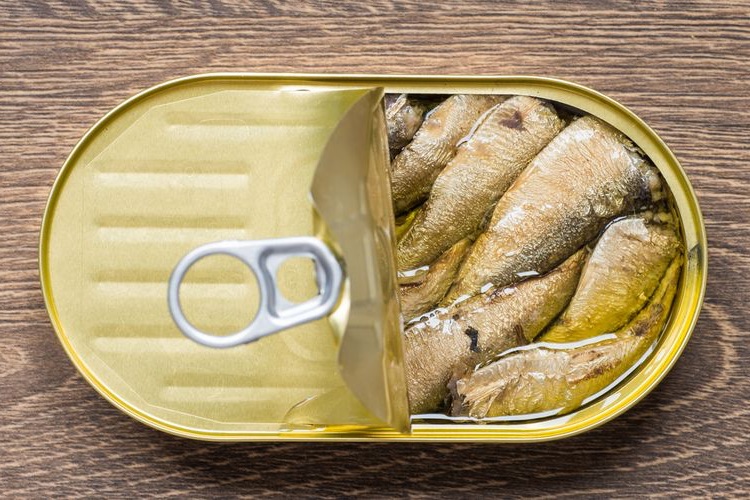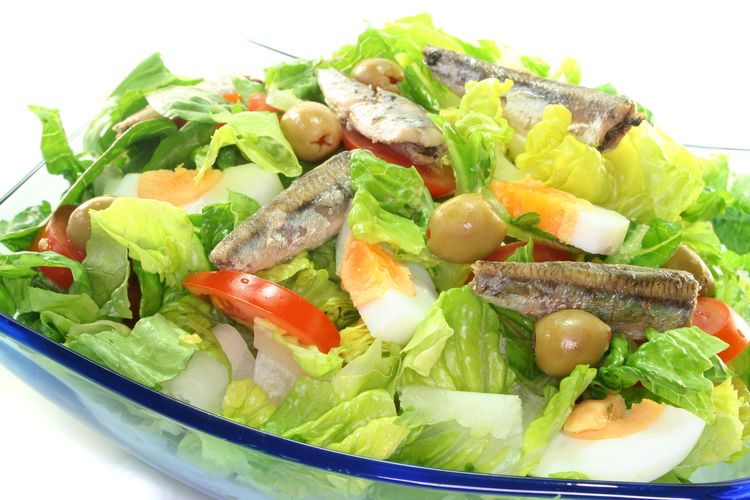Is This Food The Best-Kept Health Secret?

Once upon a time, people discovered huge schools of tiny little fish, which they named sardines, in the Mediterranean waters surrounding the Italian island of Sardinia. That was at least 600 years ago. In more recent times, research is revealing how sardines may be one of the best-kept secrets when it comes to healthy eating options.
The humble sardine packs a nutritional punch many times greater than its diminutive size. Three ounces of sardines contain only 190 calories but deliver 23 grams of protein. Now take a look at how much of your recommended daily values come from those three ounces of sardines:
- Vitamin B12 = 338%
- Selenium = 87%
- Phosphorus = 64%
- Omega-3 fats = 61%
- Vitamin D = 44%
- Calcium = 35%
- Vitamin B3 = 30%
- Iodine = 24%
- Copper = 19%
- Choline = 16%
Impressed? You should be! It’s rare to come across simple, natural foods that contain such a rich mix of nutrients.
Health Benefits of Eating Sardines
There are 21 different species of small oily fish marketed as sardines, but they all feature the nutritional profile outlined above. Here’s how eating sardines translates into health benefits for you:
Inflammation reduction. Researchers continue to discover stronger links between all kinds of diseases and the inflammatory response in the human body. In short, inflammation is a driving force behind many illnesses, including heart disease, gum disease, Alzheimer’s and dementia, mood disorders such as depression and anxiety, ADHD, a variety of cancers, arthritis, and even infertility. Omega-3 fats fight inflammation. The specific omega-3 fatty acids you get from sardines are EPA and DHA, both of which have been shown to be powerful anti-inflammatories.
The vitamin B12 connection. Vitamin B12 is absolutely essential to maintaining healthy nerve function, brain health, blood cell formation, and energy levels, and yet 40% of Americans aren’t getting nearly enough of it. This is a shame, considering that just one small tin of sardines gives you more than three times what you need.
Prevents oxidative damage. The selenium in sardines acts as an important antioxidant and is also required for the creation and conversion of an even more crucial antioxidant: glutathione. Selenium also plays a key role in partnering with iodine to regulate metabolism, help the body use and reuse vitamin C, and reduce stress on key organs such as your thyroid and liver.

Improves bone health. Sardines are rich in vitamin D, calcium, and phosphorus, all of which are important for healthy bones and teeth. When the body needs calcium, it is released into the bloodstream from your bones, which act as calcium storage facilities. Calcium helps with nerve signal transmission, blood clotting, hormone balance, and maintaining the right pH in the body. The vitamin D content in sardines helps prevent rickets and osteomalacia (soft bones), while the phosphorus also helps support healthy bone mineralization.
Mood disorder defense. It’s the omega-3 fatty acids— and especially EPA— found in sardines that help ward off anxiety and beat depression. Your body needs the right balance of omega-3 and omega-6 fatty acids to achieve optimal brain health. Because omega-6 fats are found in highly processed foods and oils that have been refined and hydrogenated, most Americans eat a diet that throws this balance out of whack in favor of omega-6 fats, which may be the driving force behind much of the depression and anxiety plaguing modern life. Sardines can give you the omega-3 fats you need to achieve a better omega fat balance.
Regulate blood sugar levels. The protein and fat content of sardines helps your body slow down the absorption of sugar, especially if you eat sardines alongside your carb-heavy foods. Because of this, sardines can be very beneficial to people suffering from diabetes.
Weight reduction. The fat/protein combination you get from sardines makes you feel satisfied and reduces cravings for more, all while delivering very few calories.
On top of that, sardines can be both a safe and sustainable source of all those nutrients. Sardines are very low on the food chain, so they’re much less susceptible to accumulating the toxins found in other fish higher up. You needn’t worry about mercury or other heavy metals at all from sardines. In fact, they’re even safe for pregnant women to eat.
Sardines have been over-fished in some areas, such as the Mediterranean. If you want your consumption of sardines to be as sustainable as possible, look for brands that are wild-caught from the Pacific region of the United States and Canada or from western European waters. Sardines do not appear to come from fish farms, which is a good thing, since farmed fish are always deficient and less healthy than those caught in the wild.
Do Canned Sardines Present BPA Concerns?
Any food product that comes in a can might have a liner containing the chemical BPA (bisphenol-A). It is an endocrine disruptor that causes hormone imbalances and wreaks havoc on animals’ reproductive health at levels far lower than what the EPA says are “safe” for humans. More research is needed here to tease out the actual impact on humans, but in the meantime, the simple remedy is to only buy sardines in cans clearly marked as BPA-free.
Sardine Recipes
Many sardines come canned in oil, but if you can’t verify that it’s a high-quality, unrefined oil, opt for water-packed instead.
There are so many ways to eat sardines— raw out of the tin, grilled, roasted, broiled. It’s very easy to just chop them up and toss them into just about anything, including salads, pizzas, pasta dishes, and scrambled eggs, or blend them into sauces and dressings. Any recipes you come across that call for anchovies can use sardines instead. Here are two easy recipes incorporating sardines:

Sardines in Egg Tahini Salad
This is an example of taking a healthy dish and giving it a serious omega-3 boost. For ingredients, you only need the following:
- 4 cups romaine lettuce
- ½ cup sun-dried tomatoes
- 1 medium scallion, sliced
- 3 tablespoons tahini
- 2 tablespoons apple cider vinegar
- 1 tablespoon Dijon mustard
- Sea salt, to taste
- Black pepper, to taste
- 4 hardboiled eggs, sliced
- 1 can (3 oz.) of sardines, chopped
Wash the lettuce and tear it up as the base for the salad, adding in the onions and tomatoes. In a separate bowl, mix the tahini, vinegar, mustard, salt, pepper, and sardines. Pour this mixture over the salad and toss. Top with slices of hardboiled eggs and serve.
Sardines in Garlicky Kale
This is a simple recipe that delivers all the benefits of three powerful super-foods: sardines, kale, and garlic. All you need are the following:
- 1 tablespoon olive oil
- 2 cloves minced garlic
- 2-3 cups chopped kale
- 1 can (3.75 oz.) of sardines, chopped into small pieces
- ¼ teaspoon sea salt
- Ground pepper, to taste
- Fresh-squeezed lemon juice, to taste
Sauté the kale, garlic, salt, and pepper in a pan for 3-4 minutes on medium-high heat (if kale starts to stick, add a little water), throw in the sardines, and sauté for another minute. Squeeze the lemon juice over it all and serve.
Summary
For being such tiny little creatures, sardines deliver a huge array of health benefits thanks to their high levels of omega-3 fats, vitamin B12, vitamin D, calcium, selenium, and other minerals. Because they are so low on the food chain, they don’t have the same risk of toxins that other fish carry. As long as you buy them in BPA-free cans, sardines might be the healthiest addition you’ll ever make to your pantry.
